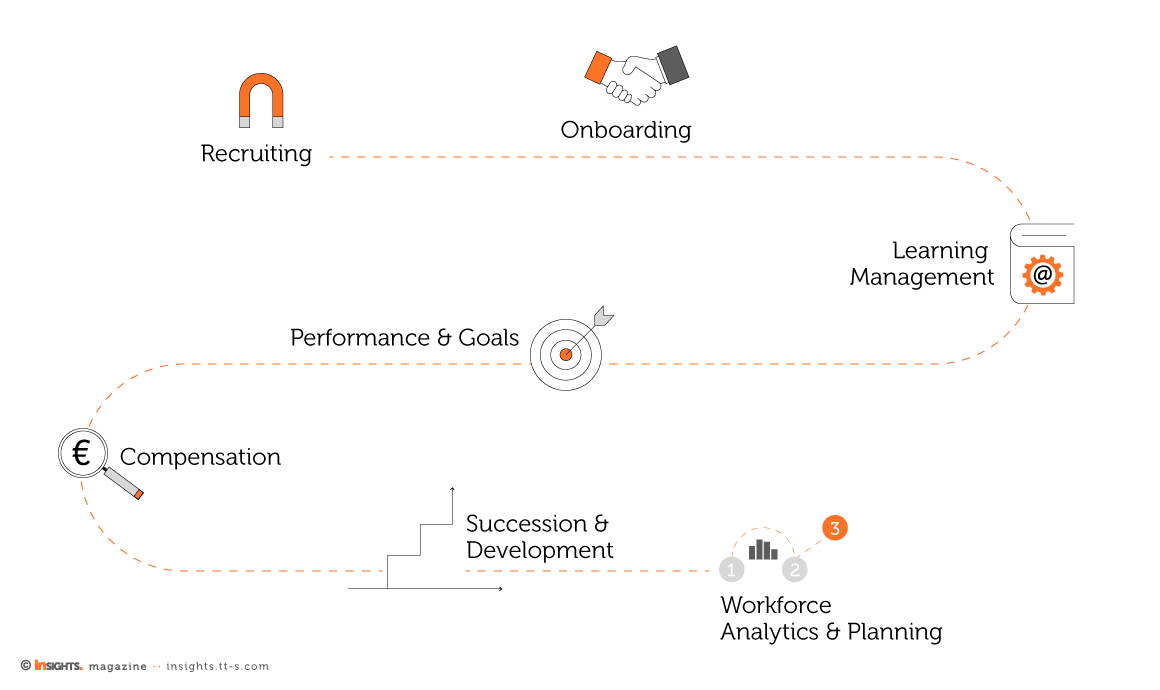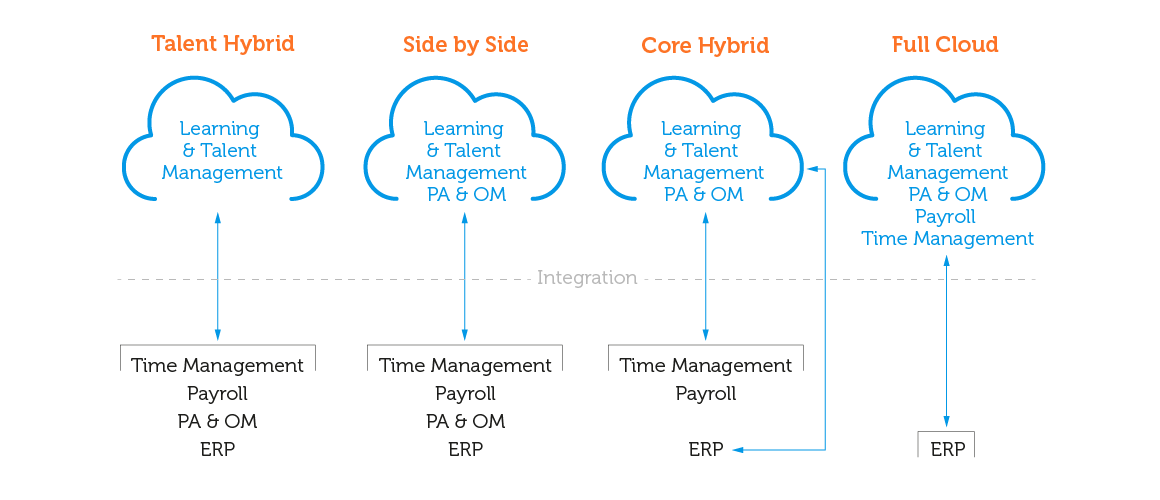SAP SuccessFactors – employee experience (EX) in the cloud

When it comes to how we organize work, the situation surrounding COVID-19 has shown us that even when it looks like we’ve hit a wall, there’s still plenty we can do. SAP is a perfect example here. In no time at all, 90 percent of work at the company was shifted to employees’ homes and there was a lot of intense debate about whether staff would need the same amount of space in the future as they had before the pandemic.
Enabler for decentralized working models under central governance
Looking at this example and lots of similar case studies, it’s tempting to think that any resolute management team faced with a crisis could restructure the working environment at a mere click of the fingers. That’s only partly true, though. Let’s face it – switching to decentralized working models is little more than a quick fix in times of COVID-19. In the long run, however, such models can only be successful if companies create a positive environment that promotes employees’ sense of belonging, well-being and productivity – even when working from home.
HR departments play a particularly important role in this respect, as they can use digital processes and the right software to provide a positive employee experience, including for remote workers. Now more than ever, cloud-based applications such as SuccessFactors are therefore increasingly coming to the fore. This is because, unlike traditional solutions for human capital management (HCM), SAP SuccessFactors enables managers and employees to access their data and the associated applications from any location. But does that automatically make it the ideal option for digital employee administration during and after the pandemic? What else makes SuccessFactors stand out, and what distinctive features need to be borne in mind when rolling out or switching to this software program?
What is SAP SuccessFactors?
The story behind SuccessFactors began back in 2001, when Lars Dalgaard founded a company under that name in California and launched the cloud-based talent management suite featuring what at that time were revolutionary functions for collaboration and analysis. In February 2012, SAP took over the company. The aim was to take Dalgaard’s straightforward talent management application and make it the go-to option for end-to-end talent and human resource management.
Today, SAP markets SuccessFactors as a comprehensive modular cloud-based package for human experience management (HXM) and therefore the next step up from human capital management (HCM). Indeed, unlike a traditional HCM suite, SuccessFactors no longer focuses on the requirements and isolated processes of human resource management. Instead, it is geared toward what employees need – from the first day of their career all the way to their retirement. This means senior staff can decide for themselves what skills are required for a vacant position, draw up job advertisements in the system and upload them to all relevant careers portals. At the same time, employees can take their training and continuing professional development into their own hands by sorting through and accessing training options independently – all as part of a user-friendly and intuitive system they can utilize from their desk, on the move and via any end device.
These two examples already reveal the strategic approach typical for SuccessFactors. Flexible function modules, which can be combined into a fully-fledged suite, are designed to digitally support and speed up all HR functions, not to mention optimize them through AI-based analysis and feedback evaluations.
The key advantage here is that the tools available for file sharing, collaboration, communication and self-services allow HR professionals to create positive experiences throughout the entire employee lifecycle. This is because employees and managers take on more responsibility and can thus achieve better results. HR doesn’t just therefore become an enabler of “New Work”, but also a strategic partner for business executives when it comes to crucial issues such as recruitment, staff retention, productivity and value creation.
Focusing on staff – key components and functions
Companies can choose from the following modules and functionalities:
Employee Central (EC)
Designed for organization and master data management, the Employee Central is pretty much the beating heart of SuccessFactors, providing the data needed to run other modules as well as interfaces to existing on-premise solutions. SAP SuccessFactors Employee Central also features pre-configured self-services for virtually all processes, extensive localization and applications for administrative tasks such as logging working hours and managing absences. There’s also Employee Central Payroll for optimizing payroll accounting.
Talent Management
Talent Management encompasses various applications for strategic staff development. These include

SAP SuccessFactors: Talent Management comprises various applications for strategic personnel development.
- Recruiting to provide the necessary support to quickly fill vacancies using best practices for every step in the application process – from advertising the role to offering the job to the right candidate. Also included, and just as vital for e-recruitment, are tools for quickly setting up an interactive careers page for applicants
- Onboarding featuring structured processes, digital assistants and milestones that can be defined on a case-by-case basis to ensure staff inductions go smoothly
- Learning Management, a platform for eLearning and blended learning content including training plans and recommendations for each individual staff member and straightforward integration of external learners and trainers
- Performance & Goals to help managers set, track and review agreed targets for their direct reports
- Compensation with all the necessary tools for the implementation of a fair remuneration system for high and low performers
- Succession & Development for succession planning and quickly filling key positions by systematically supporting candidates from the in-house talent pool from an early stage
- Workforce Analytics & Workforce Planning is the reporting and planning hub that provides real-time status updates across all components and offers opportunities to get back on track in good time. It grants access to over 2,000 HR and talent KPIs and dashboards for the analysis and AI-supported assessment of trends in headcount, employee satisfaction, motivation and staff turnover
The integration of multiple modules and processes also generates the potential for synergies that are particularly interesting from an HR perspective.
- For example, Recruiting can use data from organization management for job advertisements.
- Learning Management can provide training measures for staff development within the scope of talent management.
- Evaluations can be used to develop a cascade for variable remuneration.
- Cross-modular reports can highlight additional correlations and provide the know-how for strategic human resource administration.
The future of IT is in the cloud
According to Statista, three out of four companies across the globe are therefore keen to ramp up investment in hybrid- or multi-cloud solutions. Most importantly, SAP also believes in this vision of the future, which is why support for the classic SAP HCM on-premise will be phased out in 2030. There are lots of reasons for this, some of which are highly persuasive:
1. Updates and innovations are more readily available
One of the benefits of remotely hosted applications is that updates, new security features and process optimizations are available much faster because they are installed centrally, meaning they are ready to be used immediately. In the case of SuccessFactors, this takes place automatically every six months. By contrast, updates only become available for on-premise applications much later because deploying them on in-house servers takes a great deal of time and money.
2. Companies save on hardware, energy costs and personnel
SuccessFactors is classed as Software as a Service (SaaS), which means it is provided via the internet and hosted in SAP’s data center. If a business opts for pure cloud operation, it doesn’t need its own servers or other hardware, meaning the in-house IT team doesn’t have to worry about maintaining and updating software or making sure it runs smoothly.
3. Cloud-based HR administration is safe and secure
When it comes to cloud computing, security and compliance continue to cause the biggest concerns and difficulties. Depending on requirements, some businesses may therefore be skeptical about or completely reject the idea of running SuccessFactors in the public cloud, where they rent computing power and infrastructure or applications and services from providers such as Amazon (AWS) or Microsoft (Azure). Their attitude stems from the fact that, unlike with on-site operation, they don’t own the technical infrastructure and don’t have full control over where which data is stored or processed.
At the same time, however, in-house infrastructure would have to be safeguarded against data theft, which some companies don’t do particularly well due to their lack of knowledge or IT specialists.
By comparison, SuccessFactors is equal to online banking because the infrastructure meets CIS standards and HR data is Safe-Harbor-certified. Additionally, the data of European firms is held exclusively on EU servers that are subject to European data protection regulations and thus GDPR-compliant.
4. SAP SuccessFactors is mobile, user-friendly and eases the strain on HR
Since all data is stored centrally, anyone with the right authorization can access it from any location. The increased flexibility this brings doesn’t just make it possible for staff at the office to collaborate with their colleagues at home – it also makes the entire process exceptionally efficient. On top of that, staff and their managers are able to make changes to personal data themselves, giving the HR department more time to take care of other important matters such as scouting for talent. This works in practice, too, as even inexperienced or new employees quickly find their feet thanks to the intuitive user interface SAP Fiori.
5. Speedier implementation compared to on-premise, but less scope for customization
Compared to their on-site counterparts, remotely hosted applications are less geared toward customization, although development environments also allow for customer-specific solutions to be mapped in SAP SuccessFactors – for example in SAP Cloud Platform, Microsoft Azure or Amazon Web Services. SAP SuccessFactors offers a whole range of configuration options, too. While there is still less scope for personalization compared to SAP HCM, this also offers the advantage that the customer can roll out the solution much faster.
Make SAP SuccessFactors more flexible with extensions
Since the scope for customizing cloud products is somewhat limited on account of their architecture, SAP and its partners now offer numerous add-ons for SAP SuccessFactors that make it much more versatile pretty much “out-of-the-box”.
There are a range of options in this regard:
1. Application programming interfaces (APIs): In recent years in particular, SAP has opened up SuccessFactors further and, to this end, continuously enhanced the APIs for all modules. APIs make it possible to enter, read out, update and delete inbound and outbound data, among other things, so as to replicate employee data in other systems with ease.
2. Metadata framework (MDF): SAP SuccessFactors can also be customized via the MDF. This web-based application can be used, for example, to change business logics, individual objects and fields or the user interface of applications, say to make data storage easier or to bring workflows in line with company policies. Although options are limited, there’s no need to have programming skills.
3. Intelligent services: One and the same event can have many consequences. If, for example, a staff member leaves the business, their position needs to be refilled, the master data needs to be modified, the onboarding process needs to be organized and new equipment needs to be arranged. The built-in intelligent services enable these and other steps to be interlinked in end-to-end process workflows, with automatic notifications sent to the people in charge.
4. Add-ons: Nowadays, there is a fast-growing number of pre-configured add-ons that can be used to close functional gaps, handle processes or integrate different company systems via a shared front-end.
5. SAP Analytics Cloud (SAC): Using SAP Analytics Cloud, you can analyze and assess all company data and present it in reports. Since generally all data sources can be used for this purpose, an SAC license expands the reporting functionalities of SuccessFactors and offers programmable views and dashboards that can be integrated into the software.
Customer-specific applications in the cloud – maximum flexibility for special requests
When minor adjustments or pre-configured add-ons just won’t do the trick, you can still turn to the very best in customization – coding in the cloud. In contrast to on-premise operation, programming takes place within development environments that, like SAP SuccessFactors, are based in the cloud – ideally via SAP Cloud Platform or similar test and development environments from partners such as Google, Microsoft or Amazon.
Once again, companies have the option to integrate more services into SuccessFactors. For example, storage solutions, big data analytics, AI applications and other innovations can be added for as long as required. If the system is under strain, additional resources can also be requested. These make it possible to avoid latency during work and are charged according to usage.
As a “Platform as a Service”, SAP Cloud Platform offers a range of pre-configured services that can be used to expand and enhance existing applications. Cloud Platform is also the central hub when it comes to rebuilding existing applications to optimize them for cloud-native operation, networking processes, data and solutions, and developing new applications. The advantage is that the standardized APIs speed up the development process. In practical terms, this means that companies can, among other things, program, train and roll-out AI applications, getting them up and running on a productive basis in a matter in a matter of weeks rather than toiling away for months on end. At the same time, they retain control over the costs, as they can flexibly add on and cancel individual services in a point-based credit system.
Although there is still less potential for customization compared to on-premise solutions, that potential is anything but small. SAP partners with the right expertise can easily
- Make functional modifications to user interfaces,
- Develop bespoke mobile solutions,
- Integrate other systems such as Google Calendar and Office 365,
- Modify processes to also incorporate external users,
- Show or hide parts of an application to boost usability and productivity,
- Adapt frameworks and apps to their specific purpose in a company,
- Map entire processes that only read out data from the system once and then run completely independently of SAP SuccessFactors,
- Develop and test minimum viable products (MVPs) that quickly benefit the business thanks to short turnaround times.
Hybrid helpers for the best combination of security and performance
The development environments mentioned earlier are also the place where solutions can be created that ensure SAP SuccessFactors can be securely deployed in a hybrid cloud landscape in a way that delivers impressive results.
Such approaches make compliance-relevant applications accessible to users on the move by keeping personal data in SuccessFactors while also processing content in apps and then synchronizing it with SuccessFactors. This enables companies to combine the advantages of all cloud environments and minimize the specific drawbacks of using just one. While they use their own infrastructure to process sensitive data, they can also access innovative public cloud services and scale them as and when required.
Do you want just a bit of cloud transformation or are you looking to go all the way?
Those who opt for SuccessFactors can decide what they want their IT landscape for human resource administration to look like. In fact, they’re somewhat spoiled for choice, with four possible scenarios for rolling out and operating the suite that are split between cloud and on-premise functionalities.

There are four scenarios for the implementation and operation of SAP SuccessFactors, which differ in the split between cloud and on-premise functionalities.
Talent Hybrid – playing it safe
In Talent Hybrid mode, only talent management – the thing SAP SuccessFactors is renowned for – takes place in the cloud. All other HR processes continue to be managed on in-house servers.
In the extremely dynamic field of recruitment, customers who opt for this minimalist version due to security concerns or for compliance-related reasons directly benefit from the HXM solution’s excellent functional capabilities. In combination with the fast pace of innovation typical for cloud environments, these can quickly secure the business a significant edge on the competition, at least as far as recruiting is concerned.
The most obvious drawback to Talent Hybrid is that all core HR processes continue to run in-house and thus remain inflexible and, for the most part, lacking in innovation. Compared to that, sporadic breaks between media types and data incompatibilities due to the different user interfaces and usage concepts are of little significance.
Side by Side – two worlds, one (duplicate) data set
In the Side by Side scenario, SAP SuccessFactors Employee Central is also made available to certain sections of the organization outside of talent management, while all other employees continue to work in the legacy system. This version appeals, for example, to companies with many or newly acquired sites that still use on-site servers but are looking for a quick way to interlink their talent, master data and organization management. The data from the cloud and the on-site servers is synchronized via the relevant interfaces.
It is predominantly companies with multiple sites that use Side by Side mode as a quick way to harmonize heterogeneous HR data and processes. One possibility in this scenario is to set up a global, i.e. group-wide, reporting system. The disadvantage, however, is that employee master data from SAP ERP HCM has to be transferred via interfaces and is duplicated in SAP SuccessFactors.
Core Hybrid – central functions also in the cloud
Core Hybrid takes things up a notch, shifting almost all HR applications and data into the public cloud. Only payroll accounting and time management continue to run in SAP HCM or similar systems. Most of the time, this is because the customer has invested a lot of time and money in mapping the associated processes in accordance with tax and collective bargaining regulations, but is unable to use this in SAP SuccessFactors.
Companies that opt for this scenario greatly benefit from the cloud technology because they become more flexible and can use AI-supported services to quickly align and adjust their HR strategy based on the facts. The downside is that on-site infrastructure still needs to be kept in place. On top of this, key self-services that would save HR staff unnecessary routine tasks are unavailable.
Full cloud – cutting all ties with the Earth
In the last of the four operating modes, payroll accounting and time management also move into the cloud. Many companies still consider this a radical step, which is why they rarely go for this option if they already use SAP HCM. After all, even though they could make full use of all modules of SuccessFactors and the associated business suite without needing their own IT infrastructure, the transition to this scenario does take time and effort.
For newcomers without complex legacy systems, however, this deployment mode can present a highly interesting option. It certainly wouldn’t be a wrong move because, as already mentioned, all signs suggest the days of the on-premise world are numbered. That’s not a doomsday warning, but SAP is not the only market player driving forward this transformation, so now is the perfect time for a complete rethink of HR and IT. But fear not – you’ve still got a couple of years to make the switch.





